 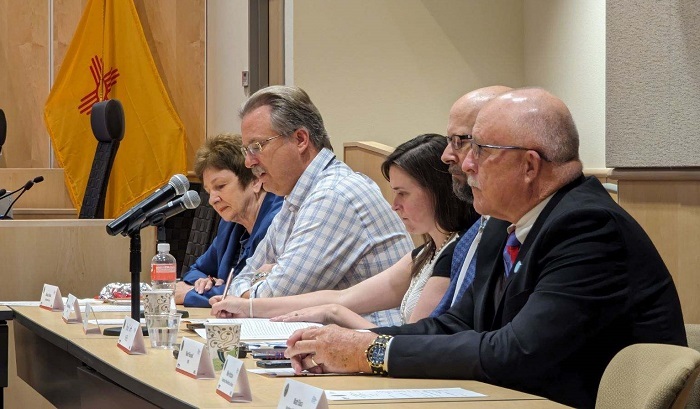 EM Los Alamos Field Office Manager Michael Mikolanis gives opening remarks as he kicks off a workforce development summit in Los Alamos, New Mexico, last week.
LOS ALAMOS, N.M. – EM co-hosted a workforce development summit on Friday with the Energy Communities Alliance and Energy Facility Contractors Group that drew a diverse group of leaders from across the region.
The well-attended event brought together city and county leaders from Los Alamos, Española, and Santa Fe, tribal leaders from the Jemez Pueblo and the Cochiti Pueblo, education leaders from area colleges, including the University of New Mexico-Los Alamos and the Northern New Mexico College, and participants from the Hanford Site area in Washington state. Also attending were leaders from the EM Los Alamos Field Office (EM-LA) and its cleanup contractor, Newport News Nuclear BWXT-Los Alamos (N3B), and representatives from Triad National Security, which manages and operates the Los Alamos National Laboratory (LANL).
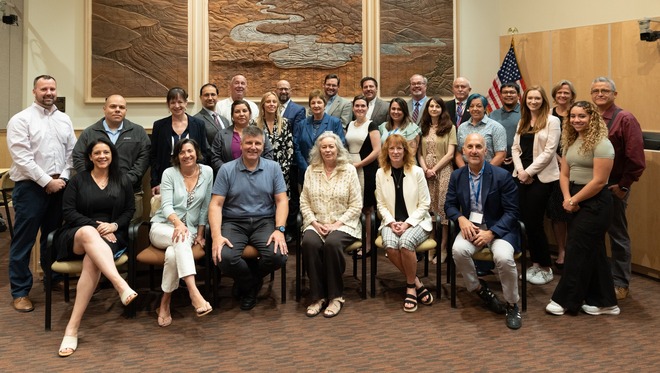 A workforce development summit held in Los Alamos, New Mexico, last week featured city, county, tribal and educational leaders from across the region.
The summit provided a forum for communities surrounding EM’s LANL cleanup site to come together to focus on unique challenges they face in hiring. As EM-LA works to strengthen its workforce, the surrounding communities are doing the same and running into many of the same challenges as leaders at EM-LA and N3B. The forum gave community representatives a platform to brainstorm and collaborate with each other as well as officials from EM, N3B and Triad.
The groups acknowledged they are trying to pull new hires from the same group of applicants, which inadvertently creates competitive tension. The attendees discussed ways they could work together to fill various positions, including creating a resume-sharing system that will help each other find qualified candidates for hard-to-fill roles.
Creating a strong pipeline for the workforce of the future was a main focus. Attendees talked about the need to help students identify job opportunities and guide them toward a future science, technology, engineering and math (STEM) related career path.
Kristen Ellis, acting associate principal deputy assistant secretary for EM's Office of Regulatory and Policy Affairs, moderates a workforce development summit in Los Alamos, New Mexico, last week. Ellis is also the EM director of regulatory, intergovernmental and stakeholder engagement. |
|
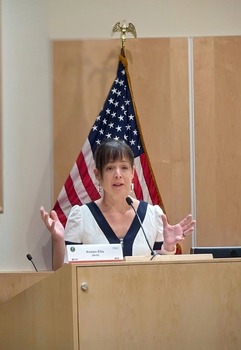 |
Participants noted that many graduating high school students are not aware of workforce development training opportunities, grants and career opportunities available through local employers such as N3B. Local leaders acknowledged they must work together with DOE and its contractors to ensure their communities are aware of those programs, which will enable students to remain local while excelling in rewarding careers.
The leaders discussed the importance of emphasizing the power of tech and trade schools to students, who are sometimes pressured into attending college. Attendees argued they must find ways to help both teachers and students consider alternative education and career opportunities.
EM plans to host similar workforce development summits with other community leaders surrounding EM sites across the DOE complex.
 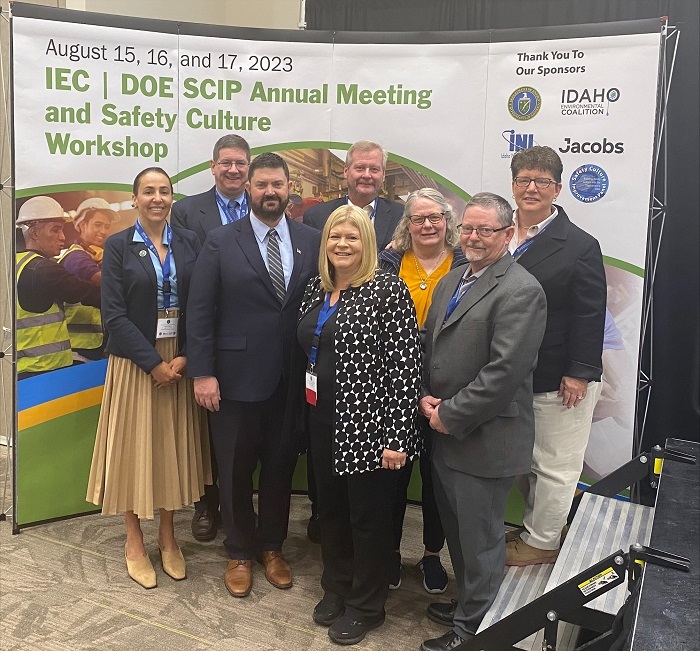 DOE employees gather for a photo at the 2023 DOE Safety Culture Improvement Panel Annual Meeting and Safety Culture Workshop, held last week in Idaho Falls, Idaho.
IDAHO FALLS, Idaho – EM’s Idaho Cleanup Project (ICP) and contractor Idaho Environmental Coalition (IEC) last week hosted the 2023 DOE Safety Culture Improvement Panel (SCIP) Annual Meeting and Safety Culture Workshop, where participants focused on all aspects of safety culture, with a special emphasis on psychological safety.
“DOE continues to promote a safety culture that embraces diversity of thought,” EM Principal Deputy Assistant Secretary Jeff Avery said in a keynote address to over 270 attendees. “We benefit not only from strong technical and operational experience, but also from the different backgrounds, life experiences and points of view that our diverse workforce brings to our mission. We are at our best when we fully mobilize the diverse talents and viewpoints of our workforce.”
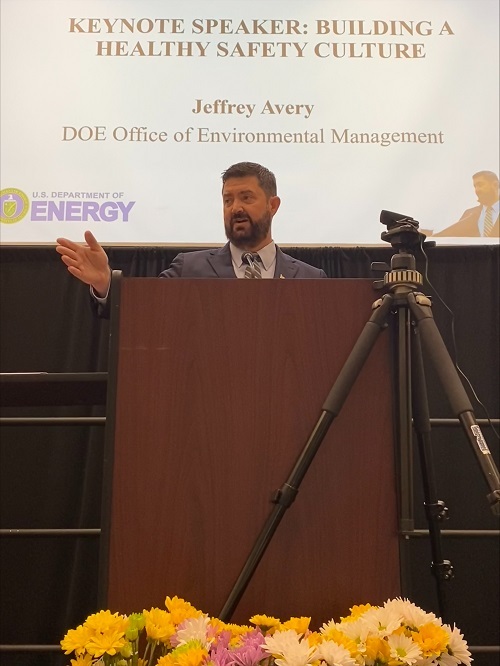 |
|
EM Principal Deputy Assistant Secretary Jeff Avery delivers remarks during his keynote address at the 2023 DOE Safety Culture Improvement Panel Annual Meeting and Safety Culture Workshop. |
Establishing a strong safety culture in which safe performance of work and involvement of workers in all aspects of work performance is a core DOE value.
Deputy Energy Secretary David Turk expressed the Department’s commitment to a healthy safety culture in recorded remarks shared at the start of the workshop meeting. And Energy Secretary Jennifer Granholm has shared her expectations for establishing and maintaining a positive culture in a previously recorded video.
“I want to make it perfectly clear that safety is a core value at the Department. Safe performance of work is the overriding priority when we plan and complete our work. It must be incorporated into every aspect of our jobs to successfully complete our mission,” Granholm has said.
Psychological safety is integral to promoting a safety conscious work environment, a positive safety culture and strong organizational climate. Presenters at the meeting explained that psychological safety is a shared belief held by team members that it’s OK to take risks, express their ideas and concerns, speak up with questions and admit mistakes — all without fear of negative consequences.
“Creating a healthy safety culture environment starts with an individual,” said Avery.
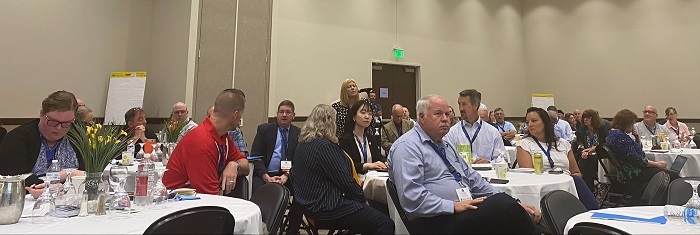 Participants in the plenary session for the 2023 DOE Safety Culture Improvement Panel Annual Meeting and Safety Culture Workshop take part in a question-and-answer session.
Established in 2015, SCIP is led by co-chairs Jack Zimmerman, director of the EM Consolidated Business Center, and Todd Lapointe, director of the DOE Office of Environment, Health, Safety and Security. The SCIP provides:
- A permanent, high-level organization within DOE devoted to promoting safety culture;
- Cross-organizational leaders focused on continuous safety culture improvement; and
- A forum to exchange information and ideas to establish, monitor and sustain measures supporting a strong safety culture.
“The collaboration of so many experts passionate about safety culture from across the Department is a real win for the SCIP,” Zimmerman said. “The discussions and lessons learned shared at the workshop provide the stimulus for attendees to return to their offices better equipped to continue strengthening the Department’s safety culture.”
The meeting included a plenary session featuring presentations on safety culture best practices by safety culture subject matter experts from the International Atomic Energy Agency, Federal Aviation Administration, National Aeronautics Space Administration, as well as SCIP members and DOE employees and contractors. Over 26 breakout sessions highlighted DOE’s safety culture focus areas of leadership, employee engagement and organizational learning.
“Safety is fundamental to EM. Success in our mission is only achieved when we eliminate the nation’s greatest environmental liabilities while adhering to the highest standards of safety,” Avery said following the workshop. “DOE’s safety culture journey is a process to achieve a strong safety culture that will never end.”
Avery added, “It is a journey, not a destination.”
  Members of the information security and records management teams with Hanford Site contractor Hanford Mission Integration Solutions prepared an extensive shipment of classified documents for delivery to the U.S. National Archives and Records Administration near Washington, D.C.
RICHLAND, Wash. – Classified records from the start of the Manhattan Project arrived safely at the U.S. National Archives and Records Administration near Washington, D.C., after EM Richland Operations Office (RL) contractor Hanford Mission Integration Solutions (HMIS) securely prepped them for a lengthy journey under escort by drivers holding top secret clearance from DOE.
The records include items from the 1940s and 1950s that hold permanent historical value, and document work done when the Hanford Site produced plutonium for the atomic bomb that helped to end World War II. The National Archives only considers 1 to 3% of documents and materials created during federal government business important enough to be kept forever.
“Records documenting work connected to the world’s first production-scale nuclear reactor are of great historical value and significant enough to preserve for their public value and educational benefits,” said Brian Harkins, RL assistant manager for Mission Support. “Permanent storage at the U.S. National Archives will allow equal access, where possible, to these notable artifacts.”
 Drivers holding top secret security clearance transported 225 boxes of World War II and Cold War-era classified records to the U.S. National Archives and Records Administration.
 Juan Guajardo, left, and Lezlie Arntz with Hanford Site contractor Hanford Mission Integration Solutions and subcontractor North Wind apply a special lock to a truck holding Hanford classified records, accessible only by the U.S. National Archives and Records Administration upon arrival.
The 225 boxes of hard-copy records were carefully prepared by HMIS information security and records management teams, who worked together to reduce classified holdings on the site while meeting a deadline set by the agency overseeing the National Archives. Soon the agency will only accept digital, or electronic, versions of eligible records.
To meet the standard for records acceptance, the project adhered to stringent requirements, including use of special boxes, indexes, classification tabs, specific stacking order and obscuring shrink-wrap for shipment. When the records were ready for shipment, teams loaded the classified material into a truck and applied a high-security lock, to which only the archives agency had a key, and a tamper-indicating bolt. Two drivers with top secret authorization transported the records to ensure 24/7 monitoring in transit.
“We are proud to see the conclusion of this project, which began in 2019 and took extensive communication and coordination,” said David Chase, HMIS vice president of Safeguards, Security & Emergency Response. “Our teams took great care in both adhering to the strict protocols required to complete the admissions process laid out by the archives agency and ensuring records protection during transport.”
-Contributor: Robin Wojtanik
 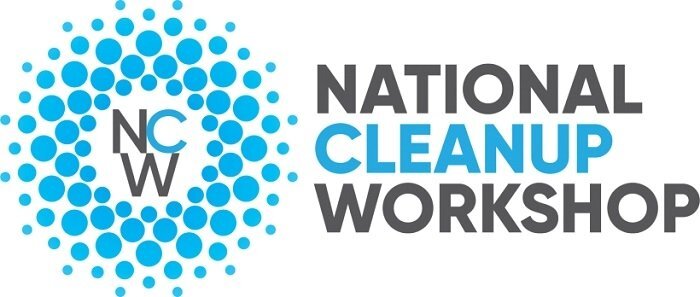
ARLINGTON, Va. – More than 70 early career professionals have signed up so far for an inaugural National Cleanup Workshop session next month that will focus on learning more about EM and how to grow and succeed in the DOE cleanup program.
“We have room for many more,” EM External Affairs Director Steve Clutter said. “The workshop offers a special reduced registration for early career professionals to attend this year’s workshop.”
The rate is offered to those who have not previously attended the workshop and have been involved in the EM program for less than five years.
With an increased focus on early career professionals, the ninth-annual National Cleanup Workshop is from Sept. 11-13 at the Crystal Gateway Marriott in Arlington, Virginia.
The Early Career Professional Session is from noon to 4:30 p.m., Monday, Sept. 11. Its agenda features remarks by EM Senior Advisor William “Ike” White on the future of EM’s workforce as well as:
- Leadership development principles;
- Case studies from federal and contractor representatives on building a career in the EM program;
- An in-depth “EM 101” on the background and history of the DOE cleanup program; and
- Lessons learned and opportunities to grow a career in the cleanup program.
The National Cleanup Workshop agenda features a lineup of senior EM leadership, along with members of Congress, state and local government officials and industry leaders from sites across the DOE complex. Key speakers include White, EM Principal Deputy Assistant Secretary Jeff Avery and Idaho Falls Mayor Rebecca Casper.
Check out this EM webpage to find coverage of past workshops, including a video of White’s 2022 workshop keynote address. The site features EM Update newsletter reporting and a gallery of photos showcasing everything from the reception kicking off the event to a variety of speakers and panels.
Last year, about 630 in-person and 91 virtual participants attended the workshop, billed as the premier annual gathering to discuss progress in environmental cleanup of former government weapons sites and nuclear research facilities. Energy Communities Alliance, with the cooperation of EM and the Energy Facility Contractors Group, host the workshop. Registration is open for this year's workshop.
Click here for more information and to register to attend.
 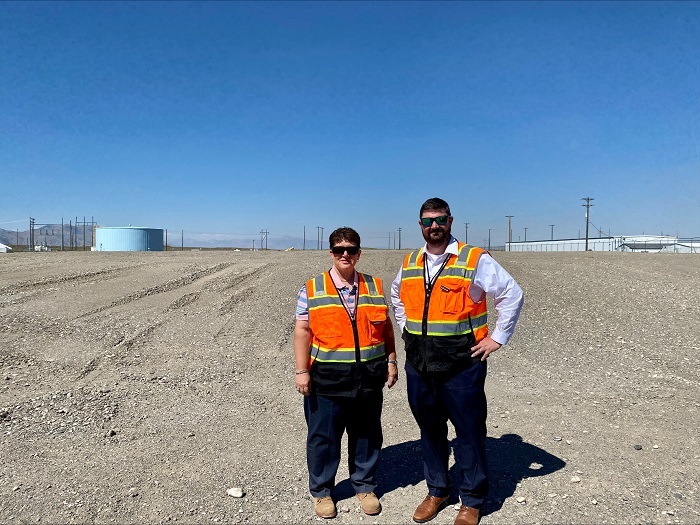 EM Idaho Cleanup Project Manager Connie Flohr and EM Principal Deputy Assistant Secretary Jeff Avery stand in front of the site where EM crews completed demolition of the waste exhumation facility that overlaid Pit 9, part of the Subsurface Disposal Area at DOE’s Idaho National Laboratory Site.
IDAHO FALLS, Idaho – The legacy of a pit that held radioactive and hazardous waste for 56 years at DOE’s Idaho National Laboratory Site has ended.
EM and decontamination and decommissioning (D&D) crews with cleanup contractor Idaho Environmental Coalition (IEC) recently took down the waste exhumation facility that overlaid Pit 9, bringing its long history to a close.
IEC’s operations and radiological controls teams prepared the facility overlaying the one-acre Cold War-era disposal pit for teardown. They created an engineered approach to pull the steel-framed structure to the ground in several sections and reduce it in size for disposal. Workers then placed the resulting debris in the Subsurface Disposal Area (SDA) and covered it with clean soil.
From 2005 to early 2022, EM crews removed targeted waste from Pit 9 and six other pits — a combined 5.69 acres of the SDA. Known as the Accelerated Retrieval Project (ARP), waste exhumation and repackaging took place in nine waste exhumation facilities. Workers have completed demolition of three of the previous waste exhumation facilities following the completion of waste exhumation, and the additional buildings remaining will be demolished in the near future. The building over Pit 9 was called ARP V.
Once all ARP buildings are demolished, the debris will be left in place and covered with clean gravel. It will serve as the base of an earthen cover to be constructed over the entire SDA to protect the underlying Snake River Plain Aquifer.
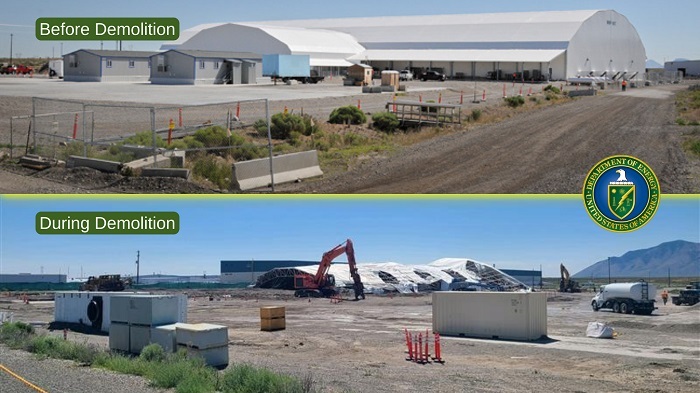 At top is a waste exhumation facility that had been built overlaying Pit 9, part of the Subsurface Disposal Area (SDA) at DOE’s Idaho National Laboratory. Immediately above is a view of the demolition of that facility. EM crews separated the waste exhumation facility into two portions that were pulled over individually. Debris from the facility was reduced in size and covered with fill material. Once the remaining structures at SDA are demolished, an engineered cover will be constructed over the entire 97-acre landfill.
Pit 9’s complex story began in the late 1960s, when it received waste primarily from the Rocky Flats Plant, a former nuclear weapon production plant and the site of one of EM’s largest, most successful cleanups.
The pit was earmarked for cleanup in the early 1990s using a physical-separation, chemical-extraction process in a record of decision signed by EM, the U.S. Environmental Protection Agency and state of Idaho.
Pit 9 then came under a fixed-price cleanup contract that failed, resulting in construction of two buildings which, following the outcome of a yearslong lawsuit, were demolished. A portion of the landfill was then used for a pilot-scale effort in which buried waste was probed and removed.
Those events over the decades led to the ARP and the targeted waste removal from Pit 9 and the broader SDA. After workers finished exhuming waste from Pit 9, an ARP facility was used to treat sludge waste. In 2018, a breach of four waste drums occurred there. Although it caused contamination in the building’s airlock interior, no external contamination was detected and there were no personnel injuries.
EM then moved the sludge treatment process to an adjacent facility as crews decontaminated the ARP V facility, removed its inner fabric and applied fixative to the inner building framework.
With the ARP V facility over Pit 9 demolished, D&D crews are now focused on the next ARP structure to be removed later this year.
-Contributor: Erik Simpson
  Pictured from left at the K-25 History Center are Jimmy Hughes, UCOR; Lanre Akande, intern with the EM Office of Regulatory and Policy Affairs; Joanna Hardin, Oak Ridge Office of Environmental Management; Alan Cumming, United Kingdom’s Nuclear Decommissioning Authority (NDA); Kent Fortenberry, UCOR; Gareth Taylor, NDA; Nancy Buschman, EM Office of Regulatory and Policy Affairs; and Nathalie Schmidt, UCOR. The visitors from the NDA learned about Oak Ridge’s history, including the completion of EM’s major cleanup at the East Tennessee Technology Park.
OAK RIDGE, Tenn. – Leadership from the United Kingdom’s Nuclear Decommissioning Authority (NDA) and Oak Ridge Office of Environmental Management (OREM) came together recently to exchange best practices for decommissioning facilities and a host of other cleanup topics.
The NDA officials’ two-day visit to Oak Ridge comes only weeks after OREM management traveled to the U.K. to view nuclear cleanup projects underway there.
“We felt there was a lot to learn by coming to Oak Ridge and having a look around, talking to people, getting information, sharing experience, because nuclear decommissioning is a global industry and we only have one language,” NDA Group Chief Operations and Performance Improvement Officer Alan Cumming said.
The NDA leaders joined their OREM counterparts to share examples of process optimization, efficiencies and technology that their teams have implemented to advance cleanup efforts.
Team members also compared contracting and performance measurement methods, explored workforce development initiatives and discussed waste disposal operations.
“We share some common opportunities as well as some common challenges,” said NDA Nuclear Operations Director Gareth Taylor. “It's reassuring to see that we're not the only ones facing these challenges. Let’s find a solution together.”
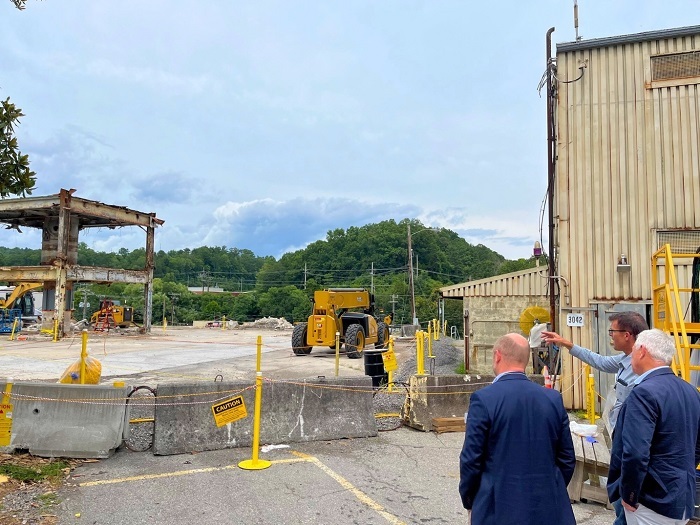 Larry Brede, UCOR cleanup manager, far right, shows Alan Cumming, center, and Gareth Taylor with the United Kingdom’s Nuclear Decommissioning Authority how crews approach demolition on the Low Intensity Test Reactor at Oak Ridge National Laboratory — an EM 2023 priority project.
Following the briefings with OREM officials, Cumming and Taylor toured active cleanup projects at the Y-12 National Security Complex, Oak Ridge National Laboratory, and East Tennessee Technology Park. The tour stops provided a firsthand look at soil remediation, reactor demolition and major construction projects.
NDA officials surveyed Oak Ridge’s current onsite disposal facility, the Environmental Management Waste Management Facility. They also viewed site preparations underway for the new Environmental Management Disposal Facility.
“It gives me a sense of pride to be part of this program,” said OREM Deputy Manager Laura Wilkerson. “We’re able to see how our work is adding value to the community, and that’s also being recognized by our counterparts across the world.”
Discussions among NDA and OREM officials will continue following the recent information exchange at Oak Ridge. Personnel from OREM and cleanup contractor UCOR have requested additional information regarding workforce development programs and approaches used by the NDA. Additionally, NDA staff are eager to learn more related to EM’s waste management and disposal operations.
“There are clearly opportunities for us to work closely together, and I think we're just at the start of that connection,” said Taylor.
-Contributor: Ben Williams
Read more EM Update stories about the cleanup program's international collaborations here.
 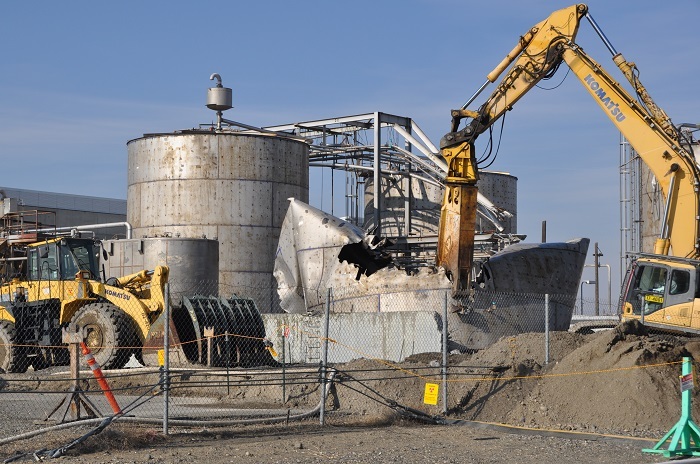 Crews with EM contractor Central Plateau Cleanup Company are removing old infrastructure near the Hanford Site’s Plutonium Uranium Extraction Plant. The facility was key to Hanford’s plutonium production mission during the Cold War era.
RICHLAND, Wash. – Demolition is underway on several former chemical storage tanks and associated infrastructure as risk-reduction activities continue at a former plutonium processing facility at the Hanford Site.
The demolition project follows months of work by EM Richland Operations Office (RL) contractor Central Plateau Cleanup Company (CPCCo) to prepare the outdoor storage area near the Plutonium Uranium Extraction Plant (PUREX) for safe removal, including remediation of asbestos-contaminated material on nearly 2,000 feet of pipeline, and isolation of mechanical and electrical systems.
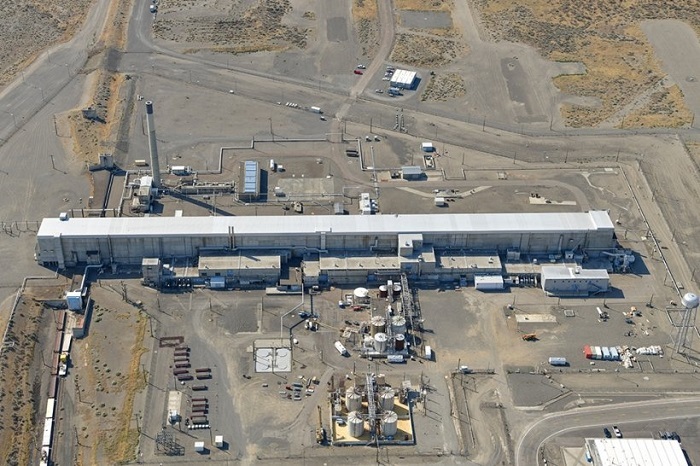 An aerial view of the Hanford Site’s Plutonium Uranium Extraction Plant. The main facility is at center. The infrastructure and tanks in the foreground are the focus of a demolition project underway.
PUREX was key to Hanford’s plutonium production mission during the Cold War era. Nearly 70% of Hanford’s irradiated uranium fuel rods were processed through PUREX, which recovered plutonium from the rods.
“Removal of the Acid Storage Area and Pump House is key to implementing safe and efficient future risk-reduction efforts for the PUREX complex,” said Andy Wiborg, RL Projects and Facilities Division team lead for Hanford’s Central Plateau Cleanup Project.
The project is expected to be completed by the end of September.
-Contributor: Dieter Bohrmann
|